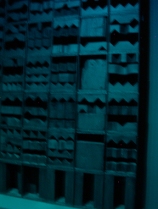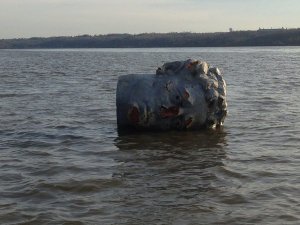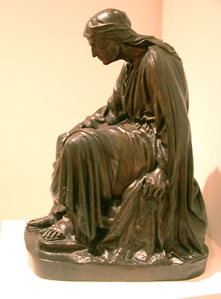 “Luminous Zag” would seem to be a contradictory title for a sculpture that is entirely black, and stands in a black-walled gallery. But “luminous” really is the best word to describe the piece, one of three sculptures and five prints in “Louise Nevelson: Black” at the Davis Art Museum at Wellesley College.
“Luminous Zag” would seem to be a contradictory title for a sculpture that is entirely black, and stands in a black-walled gallery. But “luminous” really is the best word to describe the piece, one of three sculptures and five prints in “Louise Nevelson: Black” at the Davis Art Museum at Wellesley College.
The text for this exhibition states that low lighting and black gallery walls were Nevelson’s original environment for exhibiting her work. Quotes from Nevelson’s dealers, including long-time gallerist Arne Glimcher, mention tantalizing details of her early installations. Nevelson arranged larger pieces so that they blocked the gallery windows, and painted the walls black. When possible, she used blue light. Her original intent is faithfully recreated here, and is a revelation.
Linger in the darkened, cloistered, gallery long enough to let your eyes adjust to the dim blue light, and “Luminous Zag” comes to shimmering life. The rough lumber, stained black, assumes an iridescent sheen. Greens, blues, and a range of gray tones play out across the rippling surface grain. Only shadows, the voids between the rough geometry of the wood, are entirely black.
Created in 1971, “Luminous Zag” is made up of 36 boxes arranged in six rows, each box containing jagged, rough-sawn shapes that form broadly horizontal patterns. The piece is not one of Nevelson’s largest, a mere 8 by 6 feet, but it has the monumental quality of a Mayan temple. Nevelson called herself “the architect of shadows,” and has declared that shadows are the “fourth dimension,” as important to her work as solid. Nevelson’s sculpture can look harsh and relentlessly monochromatic in a white-box gallery, but in this installation shadows create a compelling sense of mystery. The dark interstices become miniature portals that invite entry, like the low door in the wall that lured Alice from normality.
The other large sculpture in the show, “Dream House V,” is the height and depth of a person, but slightly wider, as if it might possibly accommodate two. An entrance is hinted at by hinges along one side. Made up of overlapping pieces of thin, laminated wood of various lengths and shapes, it is dotted here and there with larger chunks, faceted like gems that glow in the blue light. Once again, openings between the curves and slats of wood draw the viewer in. One peers through them into an interior that, Tardis-like, suggests the void of Space.
Also in the show are some surprising, figurative prints from the 1950s. It seems odd at this point in time to remember that Nevelson’s very early sculpture (now destroyed) was also figurative. The Davis’s installation is a reminder that Nevelson’s work could be very much about the body, or rather, the spaces it might occupy.
Photograph: Luminous Zag, 1971
https://www.davismuseum.wellesley.edu/whats-on/current/louise-nevelson-black

